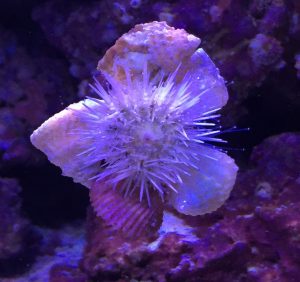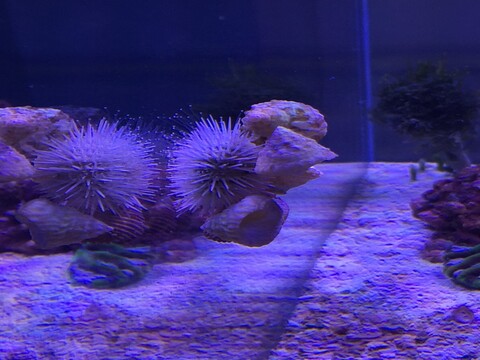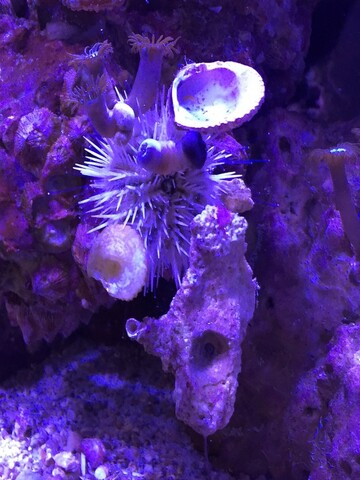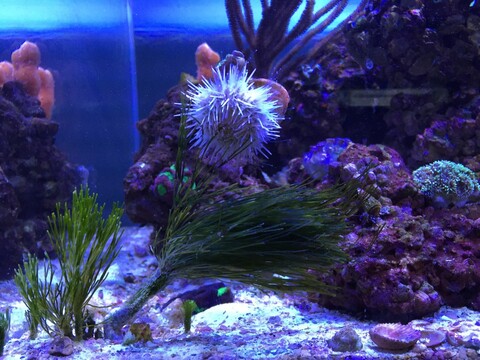Thinking of getting a pincushion sea urchin for your saltwater aquarium? It could be the coolest critter you add to your tank, or the most destructive…
I’d like you to meet Fred:

Fred is a white pincushion sea urchin. He is also a party crasher.
When I first set up my aquarium, I added 30 pounds of live sand straight from the Gulf of Mexico. While spreading the sand around the bottom of my tank, I found Fred hiding inside it. He was about the size of a grape.
He looked cool, survived a 900-mile journey as a stowaway, and was the very first creature (other than a few snails and tiny crabs) to inhabit my new 24g reef-in-a-box… albeit, unintentionally.
My wife and I quickly took a liking to him and she decided to name him Fred.
That was a little less than two months ago. Fred is now the size of a walnut. In other words, he’s a fast grower.
Let me share a few other things I’ve learned about pincushion sea urchins like Fred in the past seven weeks…
Disclosure: This article contains affiliate links. When you follow a link to purchase the products, I sometimes earn a commission, at no additional cost to you. Read my full disclosure here.
Pros of having a pincushion sea urchin in your tank:
- They are great algae eaters.
As I said, Fred has gone from the size of a grape to the size of a walnut — about 1/5″ from tip to tip — in less than two months. He cruises the live rock and glass 24-7 in search of algae to chow down on. He’s not the greatest at eating film algae – so excel at keep the glass clean. From what I’ve read though, pincushion urchins are very good at mowing down hair algae. I don’t have hair algae in my tank (*knock on wood*), so I can’t confirm this firsthand. However, considering how quick he can eat a dime-sized piece of Nori seaweed, I’d say hair algae probably doesn’t stand a chance. - They add a great touch of intrigue and uniqueness to your tank.
Since sea urchins are very unique critters, far more unusual than the usual crabs, snails, shrimp and other invertebrates, they can make for a very intriguing focal point and source of conversation for people who view your tank. - They add a lot of curiosity and comedy to a tank.
As you can see from the pictures of Fred, pincushion sea urchins love to decorate themselves with camouflage – often with items that would seem to large or heavy for them to be able to hold on to. It can be very cute to watch and see what they are going to try to grab onto and haul around next. As you’re about to see though, it can also be very risky…

Cons of having a pincushion sea urchin in your tank:
- They can get pretty big.
In an aquarium environment, they can grow as large as 8″. - They will camouflage themselves with anything that isn’t nailed down, and even some things that are.
Shells, rocks, loose coral frags, and even snails and hermit crabs often get picked up and taken for an involuntary ride. This part of the comic charm of a pincushion urchin. Combine this with the fact that… - They are very strong for their size.
This means they can knock small coral frags loose and, as they get bigger, they may also inadvertently dislodge coral or live rock (Much like a turbo snail.). If you decide to add one to your tank, make sure all your rock and coral are stable and not easy to move – otherwise, your cool little comedian may also behave like a prickly bulldozer. This picture should give you some idea of how strong pincushion sea urchins – and most other urchins – can be: Fred is only about 1.5″ in diameter and he is already easily lifting a rock his size, plus several shells and a few stems of sea mat…


A few other things to be aware of if you’re thinking one:
- If your tank is 20 gallons or 30 gallons in size algae is not prolific in your tank, you’ll need to feed it. A piece of Nori seaweed (you know, the stuff used to make sushi rolls – you can get it in most grocery stores for ~$5) will do just fine. Once a week, hold a piece that is about 1″ x 1″ gently against its spines long enough for it to feel what it is and start to take hold of it… hang it on the glass with a seaweed clip… or use a rubber band to hold the nori against a rock for the urchin to find. As the urchin grows, increase the feeding to a 2″ x 2″ piece of Nori.
- Once the urchin grows to 5″, find it a new home that is at least 75 gallons. An urchin this size really can’t sustain itself well enough to survive, thrive, and continue to grow. As much as we love Fred, he was an accidental guest and we know that his stay with us is only temporary – he will be going to a new forever home with a larger tank soon…
- If your pincushion urchin isn’t camouflaging itself with shells, rocks, or other debris, it may be a sign that it is sick or dying.
- If you REALLY want to have and enjoy a sea urchin in a saltwater aquarium that is under 30 gallons, please consider a Tuxedo urchin instead. They exhibit the same comical ‘camouflage’ behavior as pincushion urchins and only grow to about 3″ in diameter.



